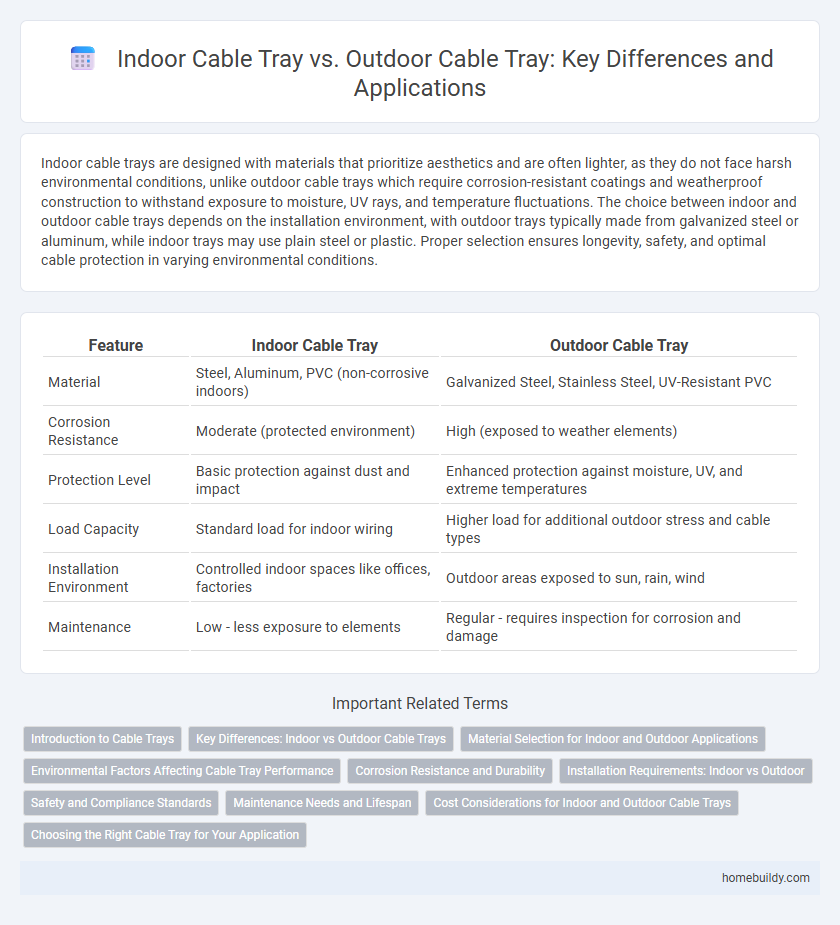Indoor cable trays are designed with materials that prioritize aesthetics and are often lighter, as they do not face harsh environmental conditions, unlike outdoor cable trays which require corrosion-resistant coatings and weatherproof construction to withstand exposure to moisture, UV rays, and temperature fluctuations. The choice between indoor and outdoor cable trays depends on the installation environment, with outdoor trays typically made from galvanized steel or aluminum, while indoor trays may use plain steel or plastic. Proper selection ensures longevity, safety, and optimal cable protection in varying environmental conditions.
Table of Comparison
| Feature | Indoor Cable Tray | Outdoor Cable Tray |
|---|---|---|
| Material | Steel, Aluminum, PVC (non-corrosive indoors) | Galvanized Steel, Stainless Steel, UV-Resistant PVC |
| Corrosion Resistance | Moderate (protected environment) | High (exposed to weather elements) |
| Protection Level | Basic protection against dust and impact | Enhanced protection against moisture, UV, and extreme temperatures |
| Load Capacity | Standard load for indoor wiring | Higher load for additional outdoor stress and cable types |
| Installation Environment | Controlled indoor spaces like offices, factories | Outdoor areas exposed to sun, rain, wind |
| Maintenance | Low - less exposure to elements | Regular - requires inspection for corrosion and damage |
Introduction to Cable Trays
Indoor cable trays are designed for controlled environments and typically feature materials like steel or aluminum with paint or epoxy coatings to resist corrosion. Outdoor cable trays require more robust construction, often using stainless steel or fiberglass-reinforced plastic to withstand weather exposure, UV radiation, and moisture. Both types provide structured pathways for electrical and communication cables, enhancing safety and maintenance efficiency in their respective installations.
Key Differences: Indoor vs Outdoor Cable Trays
Indoor cable trays are typically made from materials like steel or aluminum with protective coatings to resist indoor environmental factors, whereas outdoor cable trays require more robust corrosion-resistant materials such as stainless steel or fiberglass to withstand harsh weather conditions. Indoor trays prioritize ease of installation and aesthetic integration within controlled environments, while outdoor trays emphasize durability, UV resistance, and waterproofing to ensure long-term protection against rain, temperature fluctuations, and sunlight exposure. These key differences influence the selection process based on the installation location, environmental exposure, and maintenance requirements.
Material Selection for Indoor and Outdoor Applications
Indoor cable trays are typically made from materials such as steel or aluminum with a powder-coated or painted finish to resist corrosion in controlled environments. Outdoor cable trays require more robust materials like stainless steel, fiberglass-reinforced plastic (FRP), or hot-dip galvanized steel to withstand UV exposure, moisture, and extreme weather conditions. Selecting the right material ensures durability, safety, and longevity of cable management systems based on environmental factors.
Environmental Factors Affecting Cable Tray Performance
Indoor cable trays are typically designed to withstand controlled climate conditions, minimizing exposure to moisture, UV radiation, and extreme temperature fluctuations. Outdoor cable trays must endure harsh environmental factors including rain, sunlight, temperature extremes, and chemical exposure, often requiring corrosion-resistant materials such as galvanized steel or aluminum. Proper selection based on environmental stressors directly impacts the longevity, safety, and performance of cable tray systems.
Corrosion Resistance and Durability
Indoor cable trays typically feature materials like aluminum or steel with light coatings that offer moderate corrosion resistance suitable for controlled environments. Outdoor cable trays require robust corrosion-resistant coatings, such as hot-dip galvanizing or powder coating, to withstand harsh weather conditions, UV exposure, and moisture. Durability in outdoor cable trays is enhanced by these protective treatments, ensuring long-term performance and structural integrity in exposed installations.
Installation Requirements: Indoor vs Outdoor
Indoor cable trays require protection from environmental factors such as moisture and dust, necessitating installation in controlled environments with proper ventilation and clearance standards. Outdoor cable trays must withstand harsh weather conditions, UV exposure, and temperature fluctuations, often requiring corrosion-resistant materials and robust sealing to prevent water ingress. Compliance with specific electrical codes and standards like NEMA or IEC ensures safe and durable installation practices for both indoor and outdoor cable tray systems.
Safety and Compliance Standards
Indoor cable trays are designed to meet stringent fire resistance and low smoke emission standards, ensuring enhanced safety in enclosed environments such as commercial buildings and data centers. Outdoor cable trays require robust corrosion-resistant materials like galvanized steel or aluminum, complying with weatherproofing and UV exposure regulations to maintain integrity under harsh environmental conditions. Compliance with standards such as NEMA VE 1 for indoor installations and NEMA/EEMAC classifications for outdoor applications guarantees reliable performance and safety adherence in respective settings.
Maintenance Needs and Lifespan
Indoor cable trays typically require less maintenance due to protection from weather elements, resulting in a longer lifespan compared to outdoor cable trays. Outdoor cable trays must withstand exposure to moisture, UV radiation, temperature fluctuations, and corrosive environments, which accelerates wear and increases maintenance frequency. Selecting materials such as galvanized steel or fiberglass for outdoor trays enhances durability and extends operational life under harsh conditions.
Cost Considerations for Indoor and Outdoor Cable Trays
Indoor cable trays typically incur lower costs due to reduced material requirements and minimal protection against environmental factors. Outdoor cable trays demand more expensive, weather-resistant materials like galvanized steel or aluminum to withstand exposure to moisture, UV rays, and temperature fluctuations. Maintenance expenses are higher for outdoor installations because of the need for regular inspections and corrosion prevention measures.
Choosing the Right Cable Tray for Your Application
Indoor cable trays are typically made from materials like aluminum or steel with protective coatings to resist corrosion in controlled environments, ensuring durability and safety for electrical wiring within buildings. Outdoor cable trays require enhanced weather-resistant materials such as stainless steel or fiberglass-reinforced plastic (FRP) to withstand exposure to moisture, UV rays, and temperature fluctuations, maintaining structural integrity over time. Selecting the right cable tray hinges on environmental conditions, load capacity, and installation location to optimize performance and compliance with industry standards.
Indoor cable tray vs outdoor cable tray Infographic

 homebuildy.com
homebuildy.com